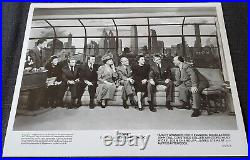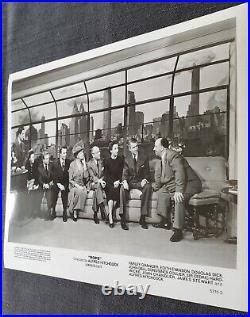1948 Alfred Hitchcock Rope Universal Press 8x10 Gelatin Silver Photo






This 1948 Alfred Hitchcock Rope Universal Press 8x10 Gelatin Silver Photo is the exact item you will receive and has been certified Authentic by REM Fine Collectibles. Sir Alfred Joseph Hitchcock KBE (13 August 1899 - 29 April 1980) was an English film director. He is widely regarded as one of the most influential figures in the history of cinema.
In a career spanning six decades, he directed over 50 feature films, many of which are still widely watched and studied today. Known as the "Master of Suspense", he became as well known as any of his actors thanks to his many interviews, his cameo roles in most of his films, and his hosting and producing the television anthology Alfred Hitchcock Presents (1955-65).
His films garnered 46 Academy Award nominations, including six wins, although he never won the award for Best Director, despite five nominations. Hitchcock initially trained as a technical clerk and copywriter before entering the film industry in 1919 as a title card designer. His directorial debut was the British-German silent film The Pleasure Garden (1925). Rope is a 1948 American psychological crime thriller film directed by Alfred Hitchcock, based on the 1929 play of the same name by Patrick Hamilton.
The film was adapted by Hume Cronyn with a screenplay by Arthur Laurents. The film was produced by Hitchcock and Sidney Bernstein as the first of their Transatlantic Pictures productions. Starring James Stewart, John Dall and Farley Granger, this is the first of Hitchcock's Technicolor films, and is notable for taking place in real time and being edited so as to appear as four long shots through the use of stitched-together long takes. It is the second of Hitchcock's "limited setting" films, the first being Lifeboat (1944)The film is one of Hitchcock's most experimental and "one of the most interesting experiments ever attempted by a major director working with big box-office names", abandoning many standard film techniques to allow for the long unbroken scenes. Each shot ran continuously for up to ten minutes (the camera's film capacity) without interruption.
It was shot on a single set, aside from the opening establishing shot street scene under the credits. Camera moves were carefully planned and there was almost no editing. The site's critical consensus reads: "As formally audacious as it is narratively brilliant, Rope connects a powerful ensemble in service of a darkly satisfying crime thriller from a master of the genre".
Hitchcock's first successful film, The Lodger: A Story of the London Fog (1927), helped to shape the thriller genre, and Blackmail (1929) was the first British "talkie". His thrillers The 39 Steps (1935) and The Lady Vanishes (1938) are ranked among the greatest British films of the 20th century.
By 1939, he had international recognition and producer David O. Selznick persuaded him to move to Hollywood.A string of successful films followed, including Rebecca (1940), Foreign Correspondent (1940), Suspicion (1941), Shadow of a Doubt (1943) and Notorious (1946). Rebecca won the Academy Award for Best Picture, with Hitchcock nominated as Best Director.
[5] He also received Oscar nominations for Lifeboat (1944), Spellbound (1945), Rear Window (1954) and Psycho (1960). Hitchcock's other notable films include Rope (1948), Strangers on a Train (1951), Dial M for Murder (1954), To Catch a Thief (1955), The Trouble with Harry (1955), Vertigo (1958), North by Northwest (1959), The Birds (1963) and Marnie (1964), all of which were also financially successful and are highly regarded by film historians. Hitchcock made multiple films with some of the biggest stars in Hollywood, including four with Cary Grant, four with James Stewart, three with Ingrid Bergman and three consecutively with Grace Kelly. Hitchcock became an American citizen in 1955. In 2012, Hitchcock's psychological thriller Vertigo, starring Stewart, displaced Orson Welles' Citizen Kane (1941) as the British Film Institute's greatest film ever made based on its world-wide poll of hundreds of film critics.
As of 2021, nine of his films had been selected for preservation in the United States National Film Registry, including his personal favourite, Shadow of a Doubt (1943). He received the BAFTA Fellowship in 1971, the AFI Life Achievement Award in 1979, and was knighted in December of that year, four months before his death on 29 April 1980.